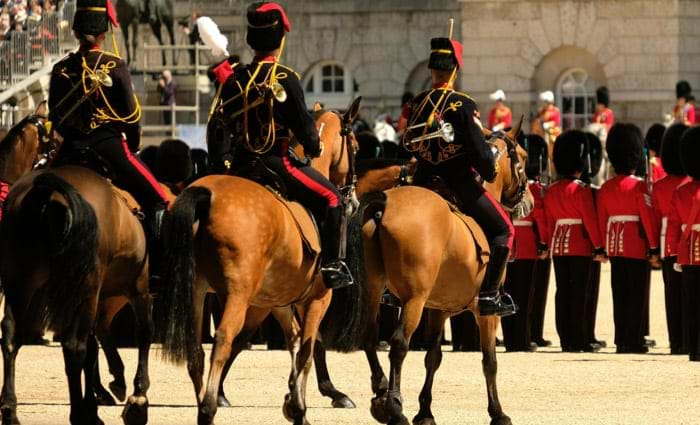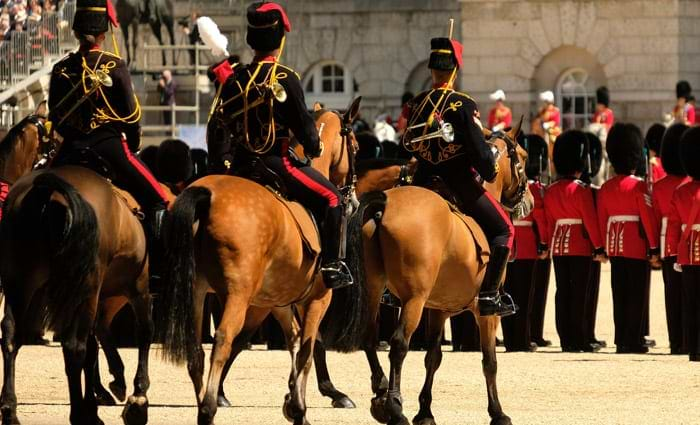
A colourful spectacle of British royal pageantry, Trooping the Colour is a majestic parade, featuring more than 1,400 officers of the Household Division, some 200 horses and ten bands and corps of drums. The ceremony has its origins in the 17th century and today celebrates Her Majesty the Queen's birthday.
The ceremony is believed to have started during the reign of Charles II, who became king of England, Scotland and Ireland. The "Colours" were the various Army regiments' flags, which played an important role at times of conflict.

© Lois GoBe / Adobe Stock
Battlefield to pageantry
Each flag identified a particular regiment. On the battlefield, the Colours were raised to enable soldiers to see a central meeting point and regroup. In the days before modern communication, there were few ways the troops could be coordinated in the heat of the battle.
The Trooping the Colours ceremony had an important practical purpose when it was launched. As each regiment paraded with their flags held high, the rows of troops would carry the Colours, while the officers would walk around them. Everyone had a chance to study the Colours in detail, so each regiment could be easily recognised on the battlefield.
Fast forward to 1748, during the reign of George II, when it was decided Trooping the Colour would become a ceremonial occasion to mark the monarch's official birthday. This tradition has continued ever since and Her Majesty Queen Elizabeth II has taken the salute at every parade since she ascended to the throne 67 years ago.
The ceremonial Trooping the Colour by the Household Division is a wonderful display of pomp and ceremony that resembles the displays of yesteryear. It has been an annual event, apart from during the two world wars. Visitors from all over the world flock to London to watch the spectacle.
Ceremony details
The event will take place on 8th June 2019, starting at 10am, when the Queen will review the troops on Horse Guards Parade and take the salute. Her actual birthday is 21st April, but the ceremony celebrates her official birthday. Trooping the Colour is held every June to mark the event.
Her personal troops, the Household Division, carry out the ceremony on Horse Guards Parade. The Queen's own love of horses is legendary and for 36 years, she rode on horseback herself during the event. She rode side-saddle, as was the tradition for a female member of the royal family. She always looks resplendent in the Colour of the regiment. Since 1987, Her Majesty has attended the ceremony in her horse-drawn carriage.
The parade always starts at Buckingham Palace and winds its way through the streets, which are lined with visitors. It passes along The Mall, Horse Guards Parade and Whitehall, before arriving back at Buckingham Palace. More than 200 musicians accompany the procession from numerous marching bands and corps of drums.
Taking the salute
When the large clock strikes 11am, the procession arrives for the Queen to take the salute. Her carriage is driven slowly around the ranks as she carries out the royal inspection of the Household Cavalry. The "Escort for the Colour" marches to the tune, British Grenadiers, during the ceremony.
The massed bands clear the way for the Escort to halt at the symbolic white stone, which is 15 paces away from the Colour Party. The Regimental Sergeant Major draws his sword to symbolise protecting the Colour. The Ensign carries the Colour through the massed ranks of guardsmen and passes it to the RSM. Following a salute, the Ensign receives the Colour back and places it in his belt.
The regiment presents arms as the National Anthem is played. Then, the Escort walks back through the ranks, to the sounds of two traditional tunes, the Grenadiers' Slow March and the Escort to The Colour. The massed bands carry out the intricate "spin wheel" manoeuvre, which isn't in any drill book, but has been passed down by bandsmen over the years.
After the parade, the Queen and other members of the royal family will appear on the balcony of Buckingham Palace to see the spectacular RAF fly-past.
Cavalry horses
The cavalry horses play a massive part in the Trooping the Colour pageantry. They are known as the Cavalry Blacks and are specially chosen for a career of guarding the royal family and the associated ceremonial duties. They have had this role since the reign of Charles II.
Ceremonial horses need to be hardy, as they have to carry not only the rider, but also the ceremonial kit, weighing around 25kg, or four stone. Cavalry Blacks are usually geldings and are at least 16 hands high, although they can be bigger.
When the Riding Master is looking for new horses for the cavalry, they are preferably unbroken, with a good temperament, no blemishes and a sturdy weight. He also looks for horses that are smooth movers. The horses, at the age of three or four, are first checked out at the Royal Army Veterinary Corps Depot.
They are then sent to the Household Cavalry in London, where a regimental number is stamped on their hooves. They are normally named after significant places or battles. Every year, new horses’ names all begin with the same letter.
Summer camp
Each summer, the regiment spends one month in Norfolk for an annual Regimental Training Camp. The horses are able to take a splash in the sea, which they enjoy immensely. All of them have been microchipped since 1997.
While the average retirement age for the regimental horses is 18, some of them are still working until well into their 20s, depending on the individual animal. A charity, the Household Cavalry Foundation, supports veterans and horses.
A book called “Nimrod: A Cavalry Black from Foal to Retirement”, written about the life of a cavalry horse by Juliet Blaxland, is donating part of its proceeds to the charity.
The Kings Troop Horses Comes to Cornwall
Based in Cornwall, Griggs Equestrian provides a range of high-quality products for horses, riders, health, grooming, yard and stable. Check out our website for details, or pop in and see us in person!





